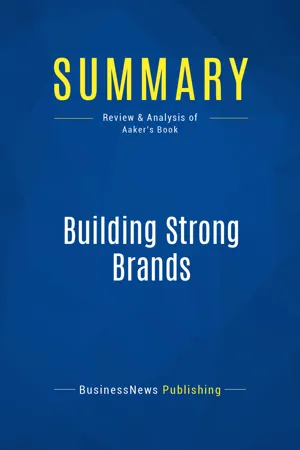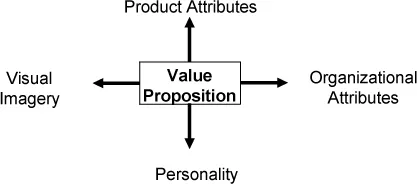
Summary: Building Strong Brands
Review and Analysis of Aaker's Book
- English
- ePUB (mobile friendly)
- Available on iOS & Android
About this book
The must-read summary of David Aaker's book: `Building Strong Brands: How the Best Brand Managers Build Brand Equity`.
This summary of the ideas from David Aaker's book `Build Strong Brands` shows that a strong brand creates customer interest and loyalty, and can be an organization’s most valuable strategic asset. In fact, brand equity is historical – the current brand image is derived from actions previously taken. Therefore, the process of adding value to a brand so that it has greater equity in the future is termed a brand identity program. Through the integration of additional product attributes, organizational attributes, personality characteristics and visual imagery, including symbols, the brand identity program adds value to the brand in the future. In essence this summary highlights that a strong brand is the strategic asset which holds the key to the long-term performance of any organization; any initiative focused on building the value of the brand is integral to the long-term viability of the organization itself.
Added-value of this summary:
• Save time
• Understand the key concepts
• Increase your business knowledge
To learn more, read `Building Strong Brands` and discover a useful book to develop successful organizations.
Frequently asked questions
- Essential is ideal for learners and professionals who enjoy exploring a wide range of subjects. Access the Essential Library with 800,000+ trusted titles and best-sellers across business, personal growth, and the humanities. Includes unlimited reading time and Standard Read Aloud voice.
- Complete: Perfect for advanced learners and researchers needing full, unrestricted access. Unlock 1.4M+ books across hundreds of subjects, including academic and specialized titles. The Complete Plan also includes advanced features like Premium Read Aloud and Research Assistant.
Please note we cannot support devices running on iOS 13 and Android 7 or earlier. Learn more about using the app.
Information
Summary of Building Strong Brands (David Aaker)
Rule #1
Main Idea
- Awareness of the brand.
- Loyalty to the brand by existing customers.
- Perceived quality of the brand.
- Associations with other valued brands.
- Competitive advantages.
- Product attributes.
- Organizational attributes.
- Personality.
- Visual imagery.
Supporting Ideas

- Awareness -- The familiarity and mental image of that brand already existing in the mind of the consumer as a result of past experience.
- Loyalty -- The likelihood a consumer will buy in the future because of favorable experience in the past.
- Quality -- The perception of the consumer that products or services using that brand will perform better and deliver a better user experience than others.
- Associations -- The other brands consumers consider to be in the same peer group, or influential users consumers would like to emulate.
- Competitive Advantages -- Any proprietary benefits the brand can deliver uniquely within that field.

- Product attributes -- The broad product class (computers, motor vehicles, etc.), function benefits delivered, perceptions of quality or value, specific uses (niche segments of the larger market), associations with specific groups of users, links to a country or region.
- Organizational attributes -- Innovation, a bias towards quality over value, environmental awareness or other areas of consumer concern, a track record of trustworthy dealings.
- Personality -- The introduction of human-like traits like casual or corporate, creative or logical, urban or rugged outdoors, cutting edge or conservative. These traits will communicate product attributes and encourage relationships to grow between the brand and consumers.
- Visual imagery -- Symbols that reinforce what the brand stands for with just a glance. Often incorporates the heritage of the brand or visual metaphors linked to product benefits or attributes.
Key Thoughts
“When consumers see a brand and remember that they have seen it before (perhaps even several times), they realize that the company is spending money to support the brand. Since it is generally believed that companies will not spend money on bad products, consumers take their recognition as a “signal” that the brand is good.”
“The brand builder who attempts to develop a strong brand is like a golfer playing on a course with heavy roughs, deep sandtraps, sharp doglegs and vast water barriers. It is difficult to score well in such conditions. The brand builder can be inhibited by substantial pressures and barriers, both internal and external.”
“What do you need to be the best? Concentration. Discipline. A dream.”
“Customers must recognize that you stand for something.”
“An orange ...is an orange ... is an orange. Unless, of course, that orange happens to be a Sunkist, a name 80-p...
Table of contents
- Title page
- Book Presentation
- Summary of Building Strong Brands (David Aaker)
- About the Summary Publisher
- Copyright